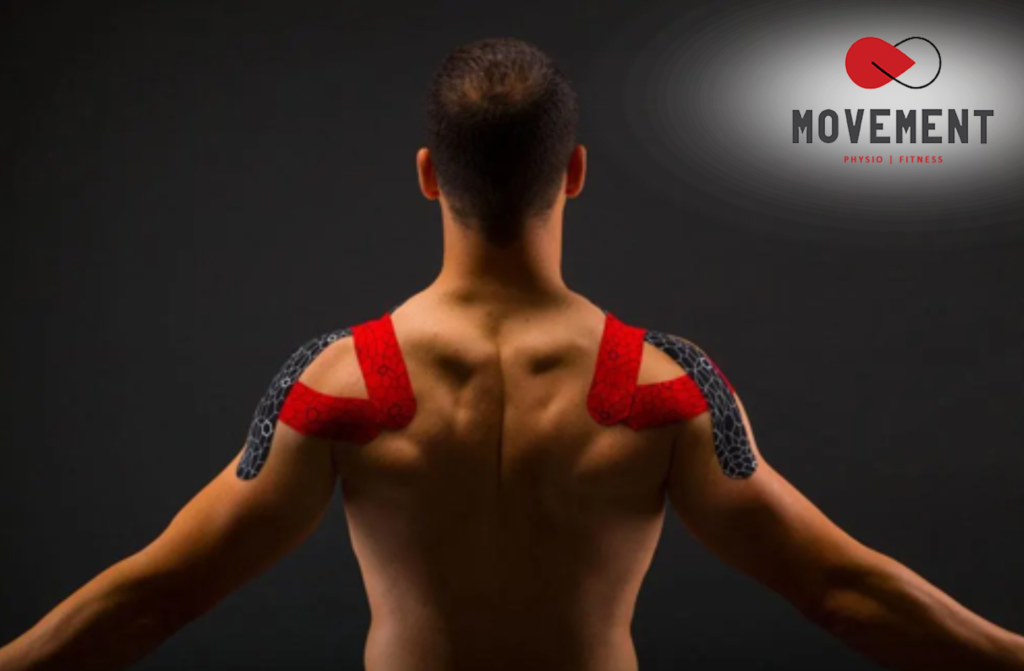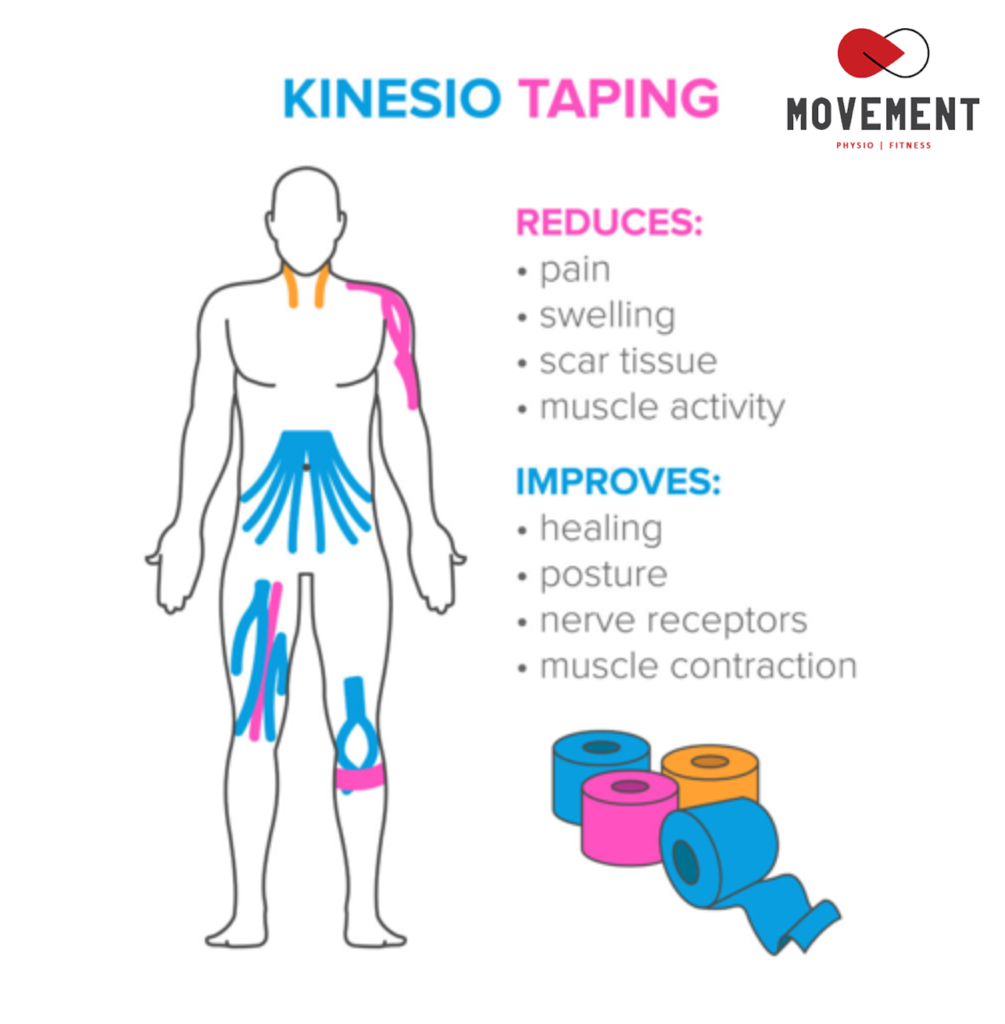What Is Kinesiology Tape?
Kinesiology tape, a product that aids in muscle support, pain relief, and swelling reduction, has a rich history. It was first introduced in the 1970s by Dr. Kenzo Kase, who developed the Kinesio Tex Tape. This tape, unlike its predecessors, was designed to provide support without limiting movement. Today, there are over 50 brands of kinesiology tape available, all inspired by Dr. Kase’s innovative creation.
If you’ve ever watched a volleyball game or a bicycle race, you’ve likely seen athletes adorned with colorful tape patterns. This is a kinesiology tape in action. It’s not just a fashion statement, but a strategic tool that athletes use to support their bodies, alleviate pain, reduce swelling, and enhance their performance.
Despite enthusiastic user reports, more research is needed to say what kinesiology taping can and cannot do definitively. However, here’s what we understand about its application and benefits.

How does Kinesiology Tape work?
Kinesiology tape is made from a stretchy blend of cotton and nylon to mimic skin’s elasticity, allowing full motion range. Its robust and water-resistant adhesive keeps it in place for days, even during workouts or showers. When applied, the tape slightly lifts the skin, which is believed to create space that may reduce irritation and improve circulation.
- Creates joint space: Studies show that taping can increase space in joints like the knee and shoulder, potentially reducing irritation.
- May change pain signals: Taping decompresses underlying tissues, which can change how the brain processes pain signals. This might explain reduced pain and increased flexibility in areas like muscle trigger points.
- May improve circulation: The tape can enhance blood flow and lymphatic circulation, which helps manage swelling and speeds recovery. Although results vary, some evidence suggests benefits for those with bruising and post-surgery recovery.
Typical uses of Kinesiology Tape
Treating injuries: Physical therapists often integrate kinesiology taping into treatment plans, especially for injuries, as it can mitigate pain and swelling.
Supporting weak zones: Kinesiology tape is also used for extra support where muscles or joints need it, such as in cases of patellofemoral stress syndrome or Achilles tendonitis. Unlike traditional athletic tapes, it allows natural movement.
Re-educating muscles: For muscles that have lost function or adopted unhealthy patterns, taping can help correct issues like poor posture or enhance gait in stroke rehabilitation.
Unlock your potential: Athletes can harness the power of kinesiology tape during events to enhance performance and prevent injuries. It serves as a gentle reminder for muscles to keep working, helping you reach your peak performance.
Managing scars: While not applicable to open wounds, there is some evidence that kinesiology tape might improve the appearance of scars post-surgery or injury. Always consult a doctor before using tape for this purpose.

Does Kinesiology Tape work?
The effectiveness of kinesiology tape is a topic of ongoing debate. While some individuals report significant benefits, scientific research has yet to conclusively support its efficacy. Current studies offer a mixed bag of results, with some showing no significant difference between kinesiology tape and placebo treatments, such as sham taping. Other studies have observed only minimal or moderate improvements. It’s important to note that kinesiology tape may be most effective when used in conjunction with other conventional treatment methods, suggesting that it’s best viewed as part of a broader therapeutic strategy.
Enhanced effectiveness: Evidence suggests that kinesiology tape tends to be most effective when used in conjunction with other conventional treatment methods. This means that while the tape can provide some benefits, it truly shines as part of a comprehensive therapeutic strategy, giving you confidence in its potential.
Use with caution: Kinesiology tape is not a one-size-fits-all solution. It’s important to be aware of specific situations where applying kinesiology tape could be harmful, ensuring your safety and well-being.
Kinesiology tape is not suitable for everyone or all conditions. There are specific situations where applying kinesiology tape could be harmful:
- Open wounds: Placing tape over open wounds can obstruct healing and increase the risk of infection or further skin damage.
- Deep Vein Thrombosis (DVT): For those with DVT, increasing fluid flow might cause a blood clot to move, potentially leading to life-threatening conditions.
- Active cancer: Enhancing blood supply to an area with cancerous growths can accelerate growth and spread, posing severe health risks.
- Post-Lymph node removal: In cases where lymph nodes have been surgically removed, applying tape can lead to problematic swelling due to improper lymphatic drainage.
- Diabetes: Diabetic individuals often have reduced sensation, which could prevent them from noticing adverse reactions to the tape.
- Allergy to adhesives: People with allergies to adhesive materials might experience severe skin reactions.
- Fragile skin: Taping could lead to tears or further injury for delicate or easily damaged skin.
How to apply Kinesiology Tape
Applying kinesiology tape correctly is crucial to achieving the best results and avoiding potential issues. It’s essential to consult a physical therapist with specific training in kinesiology taping before applying it yourself. Here’s a step-by-step guide to the process:
- Consultation: Start by seeing a trained physical therapist. They can assess your needs and determine the best taping strategy for your condition.
- Learning the Techniques: Your therapist will demonstrate how to apply the tape in patterns that best address your issue. Common taping patterns include X, Y, I, or fan shapes, chosen based on your therapeutic goals. Depending on your situation, you may need both stabilization and decompression strips.
- Practice: Under the supervision of your therapist, practice applying and removing the tape. This will ensure that you can safely and effectively manage the taping.
- Long-Term Strategy: Remember, as Dr. Megann Schooley advises, “Taping is not a permanent solution.” The ultimate goal is to build strength and address the underlying issue through physical therapy and exercises. Taping is just one tool to help along the way.
Following these steps ensures that the kinesiology tape is applied to maximize its therapeutic benefits. At the same time, you work on a long-term solution to your physical concerns.
How to safely remove Kinesiology Tape
If the tape has been on for more than a few days, it may start to loosen naturally. Here’s how to remove it gently:
- Loosen the tape: Apply oil (such as baby or olive oil) or lotion over the tape to soften the adhesive.
- Gentle removal: Slowly lift the end of the tape. Avoid pulling it off quickly or yanking it.
- Technique for removal: Pull the tape away from the skin instead of pulling it back against itself while pressing down on your skin to ease the separation.
- Support Your Skin: Use your other hand to gently compress the skin as you pull, and walk your fingers along to support the area.
- Aftercare: If your skin shows signs of irritation or damage, refrain from reapplying tape and consult your physical therapist or doctor.
Following these steps will help you apply and remove kinesiology tape effectively, maximizing its therapeutic benefits while minimizing discomfort or skin damage.
Will Kinesiology Tape harm my skin?
The adhesive used in significant kinesiology tape brands is typically latex-free and hypoallergenic, designed to minimize the risk of allergic reactions. However, even though these tapes are generally safe for most people, individual sensitivities can vary. To ensure that the tape does not irritate your skin:
- Test before complete application: It’s prudent to apply a small test strip to an area of your skin before using a more significant piece. This allows you to monitor for any adverse reactions without substantial risk.
Understanding Kinesiology Tape’s effectiveness
While the research on kinesiology tape’s effectiveness is still emerging, many users report beneficial outcomes such as increased support, enhanced circulation, reduced pain, and improved function in joints and muscles. However, here are a few things to keep in mind:
- Consult a professional: Always speak with a physical therapist before using kinesiology tape. A therapist can advise on whether the tape suits your specific condition and how to integrate it effectively with other treatment methods.
- Complementary treatment: Kinesiology taping is most effective with other therapeutic interventions. It should not be relied upon as a standalone treatment but as part of a broader rehabilitation program.
At Movement, our therapists are certified and specialized in Kinesiology Taping, so please feel free to contact us if you want to try it; we will take it from there.
